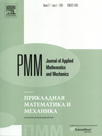 | | Journal of Applied
Mathematics and Mechanics
Russian Academy of Sciences | | Founded
in January 1936
(Translated from 1958)
Issued 6 times a year
ISSN 0021-8928
(print version) |
Archive of Issues
| Total articles in the database: | | 10610 |
| In Russian (ŌŐŐ): | | 9811
|
| In English (J. Appl. Math. Mech.): | | 799 |
|
| << Previous article | Volume 77, Issue 4 / 2013 | Next article >> |
| O.B. Gusíkov, "A self-consistent field method applied to the dynamics of viscous suspensions," J. Appl. Math. Mech. 77 (4), 401-411 (2013) |
| Year |
2013 |
Volume |
77 |
Issue |
4 |
Pages |
401-411 |
| Title |
A self-consistent field method applied to the dynamics of viscous suspensions |
| Author(s) |
O.B. Gusíkov (Moscow, Russia, ogskv@mail.ru) |
| Abstract |
A method for the approximate solution of the problem of many bodies of spherical form in a viscous fluid is developed in the Stokes approximation. Using a purely hydrodynamic approach, based on the use of the concept of a self-consistent field, the classical boundary value problem is reduced to a formal procedure for solving a linear system of algebraic equations in the tensor coefficients, which occur in the solution obtained for the velocity field and pressure of the liquid. A procedure for the approximate solution of this system of equations is constructed for the case of dilute suspensions, when the ratio of the size of the dispersed particles to the characteristic distance between them is a small parameter. Finally, the initial boundary value problem is reduced to solving a recurrent system of equations, in which each subsequent approximation for all the required quantities depends solely on the previous approximations. The system of recurrent equations obtained can be solved analytically in any specified approximation with respect to a small parameter. It is shown that this system of equations contains in itself all possible physical formulations of the problems, and, within the frameworks of the mathematical procedure constructed, they are distinguished solely by a set of specified and required functions. The practical possibilities of the method are in no way limited by the number of dispersed particles in the fluid. |
| Received |
29 November 2012 |
| Link to Fulltext |
|
| << Previous article | Volume 77, Issue 4 / 2013 | Next article >> |
|
 If you find a misprint on a webpage, please help us correct it promptly - just highlight and press Ctrl+Enter If you find a misprint on a webpage, please help us correct it promptly - just highlight and press Ctrl+Enter
|
|

 Russian
Russian  English
English